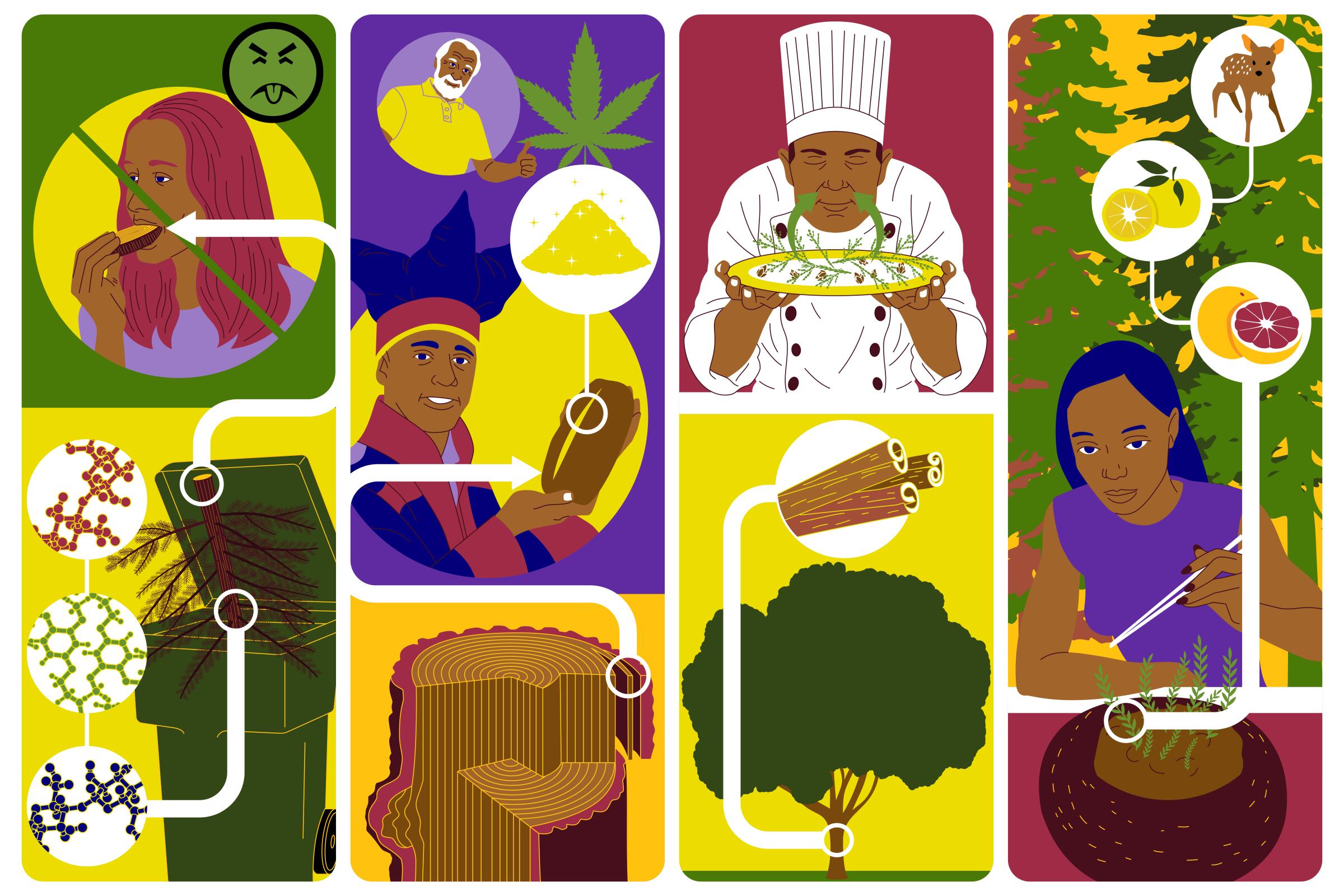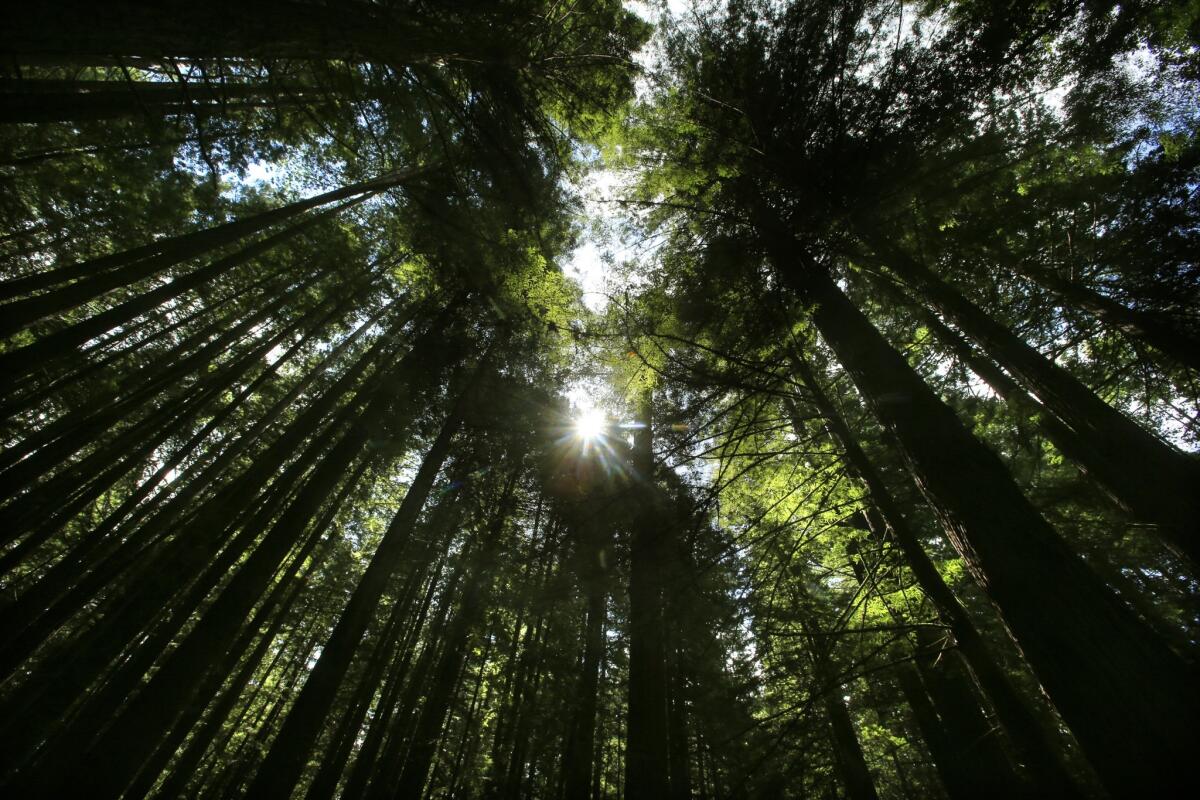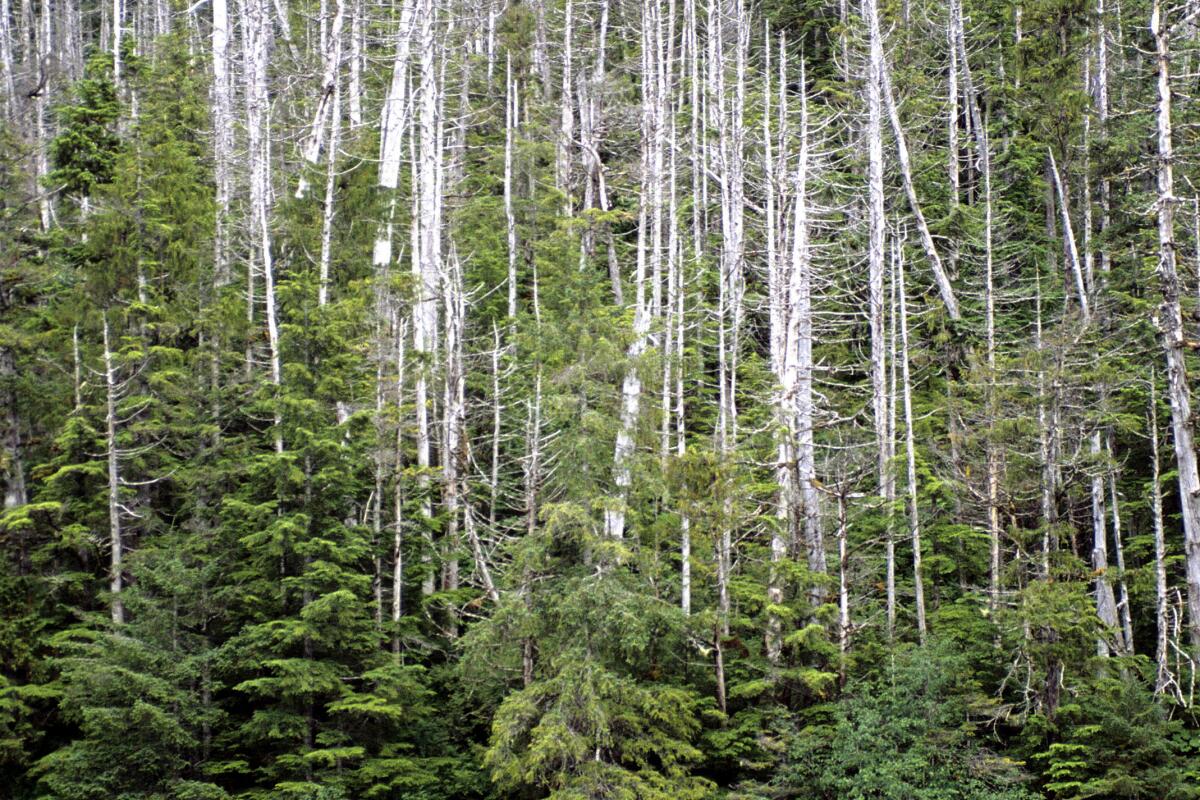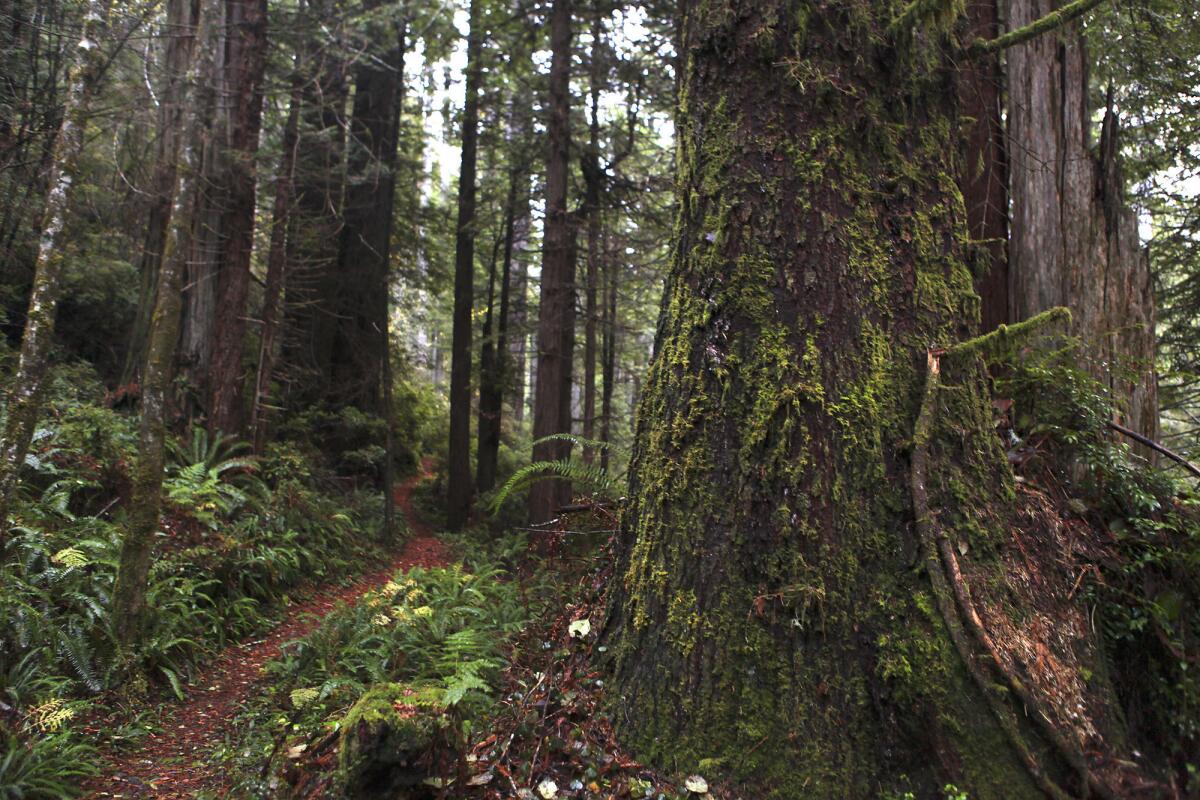Newsletter
Eat your way across L.A.
Get our weekly Tasting Notes newsletter for reviews, news and more.
You may occasionally receive promotional content from the Los Angeles Times.

Each year, Americans cut down about 15 million Christmas trees in the name of festive cheer. Those of you who follow dining trends may have an idea of new-Nordic developments in pine and spruce as seasonings, but how should the naive tree-eater approach arboreal edibility?
First off, don’t try to eat the wood from a tree. Wood is mostly made of materials humans do not possess the biochemical machinery to digest. But even though we can’t chow down on trees whole, there are parts we can eat.
Why bother making the attempt? Because trees are aroma and flavor powerhouses.
Look to the parts of the tree that do the most living, growing, competing and interacting with the outside world: the leaves, shoots, tips, young stems and outer, sugar-and starch-rich layers of the trunk.
The official L.A. Times list of the 101 best restaurants in Los Angeles, curated by our restaurant critics.
The inner layer of the bark, called the phloem, has the job of circulating the sugar produced by photosynthesis around the rest of the tree in the form of sap. Fresh from the tree, sap is limpid and watery and barely sweet. Both birch and maple saps are tapped in cool Scandinavian and Canadian regions as an as-is refreshing drink, or boiled and concentrated down into birch or maple syrups.
The tree’s sap-carrying phloem is, unsurprisingly, full of sugars. Sámi bakers in northern Sweden, Norway and Finland harvest it and the next layer in, the starch-rich vascular cambium, from birch and pine trees, dry it, grind it, then incorporate it into aromatic breads and crackers along with more typical starch-rich flours.
Like many plants, trees are prodigious producers of a class of aromatic molecules called terpenes (a word you might have heard thrown around by the weed connoisseurs in your life). Think of terpenes as a large extended family: They’re all built from a simpler rearrangeable building block called isoprene, and while they’re all shaped differently, it’s possible to see a shared nose arch here, the same jawline there. There are lots of them, and they have a lot of different aromas and flavors, with a lot of sensory blending and overlap.
A complete guide to what you can smoke and where at the new cannabis cafe in West Hollywood.
In terpenes’ natural role, they act as signals, repellants and adaptogens for the plants that make them. For our purposes, they’re what make the smells and flavors of citrus, herbaceousness, woodiness (duh), spices, resins, piney-sappiness and florals.
Correspondingly, terpenes and other aromatic, defensive molecules are also present in large amounts in woods, citrus peels, herbs, spices, sap, conifer needles and flowers; in trees, most especially in vulnerable places such as the bark, leaves and needles and the inner heartwood. Lavender, sandalwood, citrus peels, cedar, mint, oak, cumin, sage, cardamom, geranium, saffron and pine needles, to name a few, all get their aromas mostly from terpenes. Roses, cloves, parsley, vanilla and basil all have terpenes too, as well as some extra second-cousin aroma molecules that plants build from amino acids. The tender inner bark of trees in the Cinnamomum genus is so packed with aroma molecules that it’s used for seasoning, in the form of holiday staples cinnamon and cassia.
A rich supply of terpenes and other aroma molecules make otherwise inedible tree parts an attractive prospect for flavorful cooking, when the cook knows how to make use of them.
At Vespertine in Culver City, chef Jordan Kahn experiments with the flavor potential of the local arboreal ecosystems. Vespertine recently served a menu featuring eight different trees as ingredients: redwood, spruce, balsam fir, deodar cedar, Pacific madron, birch, yucca and Mt. Wilson Douglas fir. Some he uses for their shaggy, easily shed bark; some for aromatic sap; others, their flowers or needles.
Their diversity of forms and flavors expresses a complex sense of place for Kahn: “Right now, in season, are guavas and Douglas fir shoots, and these things feel like they should not coexist in the same city. And yet, somehow, impossibly, they are, and I love that about this place.”

Besides seasoning guavas with Douglas fir, another standout tree flavor for Kahn comes from the leaved suckers or sprouts that grow low down on redwood tree trunks. While foraged ingredients are sometimes read as a particular political statement about locavorism, using redwood is, for Kahn, more of a connection to both youthful sense memories and this subliminal sense of familiarity. Originally from Georgia, he says a fateful family road trip started an association he has returned to again and again in his cooking. “We went to see the redwoods at Sequoia National Park. And that left the strongest impression on me of this place. When I think of California I think of the redwoods,” he said.
He describes the redwood sprouts as asparagus-like, snappy, tender and juicy: “The flavor is amazing. The aroma is amazing. They have some resinous, kind of sticky qualities. It’s kind of borderline grapefruit, yuzu, pine. Tons of acidity. It’s very evocative.”
At Vespertine, they juice the sprouts and use the tangy, aromatic juice as a beverage or in desserts.
In coniferous trees such as redwood and cedar, as well as in herbs, leaves produce a blend of different aromatic and flavorful molecules that changes in composition as the leaf gets older and its defensive needs change, sort of like how a baby fawn has a coat dappled with white to blend in with the light pattern of the forest floor that gradually shifts to all-brown as it gets bigger. Young redwood leaves like the ones on its green sprouts contain particularly high concentrations, compared with their more mature counterparts, of very citrusy, woody, spicy, and piney-flavored terpene molecules like alpha-pinene, limonene, and myrcene.
The flavor blend — the result of turning trees into something we encounter on the table — resonates with people, according to Kahn.
“Everybody finds redwood delicious — it has a familiarity to them. They don’t always know how to place it,” he said. “But everybody’s always fascinated by it.”
Now we just need somebody to come up with a recipe for leftover Christmas trees.

The flavor is amazing. The aroma is amazing. They have some resinous, kind of sticky qualities. It’s kind of borderline grapefruit, yuzu, pine. Tons of acidity. It’s very evocative.
— Jordan Kahn
Of course, North America’s endemic trees and shrubs including cedar, juniper and sassafras have a long history of use in Native American cuisines and pharmacopeia. Needles, leaves and roots are used for their aromatic qualities—in foods, in medicine and for ceremonial and functional purposes.
Brian Yazzie, a Navajo chef who has appeared on the PBS “Independent Lens” series “alter-NATIVE Kitchen,” has cooked with cedar and other woody tree products from childhood, when his grandmother would prepare cedar-leaf tea for ceremonial and medicinal purposes, most often when someone had a cold or the flu. Cedar leaf oils contain a lot of a particular terpene molecule called thujone, which has a menthol-camphor aroma, antifungal and antibacterial properties, and is also made by other plants traditionally used for medicines, including wormwood.
“Growing up, cedar was more about medicinal and ceremonial use,” Yazzie told me recently, but the smell of steeping cedar stayed with him through moving to Minnesota and starting a career as a chef. “It wasn’t until I started working and researching more with indigenous food, and [thinking about] the term ‘food is medicine,’ that I realized that not only can you use cedar, sweetgrass or sage for medicines and ceremonies but you can use them all for food as well.”

Today, he makes cedar tea by gathering a cupful of the green, needle-y leaves and simmering them in a half-gallon of water for 10 to 15 minutes to extract their slightly sharp, woody and freshly camphoraceous flavor. For a drink, he sweetens the cedar tea with maple syrup.
When exploring new uses for indigenous ingredients, Yazzie says he reaches out locally: “There are conversations I have with elders across different tribal communities ... before I cook these types of food. I always ask the tribal protocol, what I can and can’t use. ... It’s just about being appropriate with it, knowing the boundaries, and also sourcing locally for it before purchasing from commercial companies.”
He’s also been developing techniques to use tree teas to flavor other dishes: “I like to use cedar or juniper as an addition to infuse into the water before I make corn mush or polenta, just to get more flavor from the cedar. I’d make a tea from the leaves, take them out, then add in the cornmeal.” The double infusion, first cedar, then corn, creates layers of flavors like a bouquet garni of herb leaves does in a cassoulet — but expressive of its own place and time.
Wood is made up, primarily, of the molecules cellulose, hemicellulose and lignin. The first two are carbohydrates, and sister molecules. Both are large, many thousands of individual sugar molecules linked into long chains. Hemicellulose is a more forking, eclectic molecule to cellulose’s straight-and-narrow, all-glucose polymer. Both require special adaptation to use for energy, and often fermentation by commensal bacteria, stored and secreted away in special sacs, paunches and pouches along the route of the digestive system, like cows’ rumen and multiple stomachs. Beavers, which do actually eat trees, or mostly the cellulose-rich parts of trees, do something called “hindgut fermentation” to break the cellulose down, in their cecum, which is between the large and small intestines.

Lignin, the really hard and woody part of wood, is a complex, branching, nonrepeating large molecule built not from sugars, but from structures called methoxyanisoles. Some of the few creatures that can deal with lignin are filamentous fungi; for a very long time after the emergence of trees and woody plants but before fungi came on the scene, dead trees just piled up and never decomposed, covering the earth in wood detritus. Some geologists hypothesize that all this plant matter, rather than compressed dinosaurs, is the source of the oil and gas deposits in the earth’s crust that we call “fossil fuels.”
You can experience fungi’s revolutionary lignin-to-biomass alchemy if you eat shiitake mushrooms, which prefer to grow on and digest the lignin in dead wood.
Eat your way across L.A.
Get our weekly Tasting Notes newsletter for reviews, news and more.
You may occasionally receive promotional content from the Los Angeles Times.